
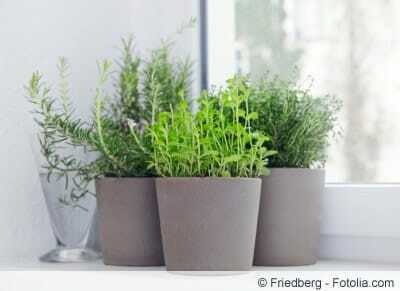
Table of contents
- Location & plant substrate
- Appropriate herbs
- planter
- Temperature, humidity & light requirements
- watering & fertilizing
- harvest
- Pests & Diseases
- Conclusion
Fresh herbs refine the menu with a spicy flavor and also have many health-promoting properties. However, there is not always a garden available for planting, and there is also a forced winter break in the cold season. In these cases, it makes sense to grow herbs and spices in the apartment and/or in the kitchen and to harvest them immediately if necessary. In this way, fresh herbs are available to the hobby cook for cooking all year round.
Location & plant substrate
Cultivating herbs on a window sill allows you to harvest fresh herbs for the kitchen without seasonal restrictions. The sun, the incidence of light, the constant room temperatures and the absence of the onset of winter guarantee a continuous growth of herbs in living spaces. In this way, no one has to use dried and frozen herbs in the cold winter months fall back on, but can also use freshly harvested and self-grown dishes to taste your favorite dishes use herbs. If there is a pet in the household that likes to play with plants and herbs, then a higher location should be selected that the animal cannot reach. The following aspects should be considered with regard to the location and the plant substrate:
- Sort herbs according to site requirements and soil quality
- Choose suitable planters
- Lay drainage under the plant substrate to improve permeability
- For lean soil conditions, mix the soil with some sand
- Cactus soil can also be used as an alternative
- Use rich compost or potting soil for nutrient-rich soil
- Sun-kissed herbs need south-facing windowsills
- Mount or hang at a height for strong sunlight
- Explore partially shaded areas, observe the incidence of light during the day
- When planting in groups, pay attention to herbs with similar requirements
Appropriate herbs
Fresh herbs still taste best; in contrast to frozen products from the shops, they have a much more intense aroma. Of course, most native herbs thrive far better in the garden bed than on the windowsill in living spaces. But there are also some southern herbs which, due to their origin from warmer climes, do not tolerate the local winters well. These sensitive and not frost hardy types of herbs are better kept on the windowsill. In principle, almost all common types of herbs can be used for planting on the windowsill:
- Pay attention to relatively undemanding and easy-care herbs
- Warmth-loving, Mediterranean herbs are ideal for the windowsill: oregano, rosemary and thyme
- Also suitable are: basil, nasturtium, chervil, bay leaf and lemon balm
- Wild garlic and peppermint are particularly fast-growing
- Parsley grows slowly
- Chives and mint need cool and shady places
- Always pay attention to the growth height of the variety and the corresponding space available
planter

Ideally, the various types of herbs are placed in individual planters so that they can develop undisturbed. In this case, it is also easier to meet the differing demands on the incidence of light and the quality of the soil. If you want to try something new, you can use individual herb easels, which are placed on the window sill. Also unusual are garlands of herbs that hang down directly on the window and can be equipped with several small pots at the same time:
- Choose planters large enough for the respective type of herb
- Balcony boxes, flower pots, hanging baskets, tubs and planters are ideal
- Use suitable coasters so that no harmful puddles of water form
- Minimum size of the container for individual plantings: diameter of 14-20 cm
- Natural terracotta pots and colorfully painted ceramic vessels are very attractive
- Vessels can be adapted to the respective room decoration
Tip:
If the standard planters are too boring for you in terms of design, you can use original baskets as cachepots.
Temperature, humidity & light requirements
If the lighting conditions in the apartment are rather dark, then this factor must be taken into account when buying herbs. In this case, types of herbs are appropriate, which get along with little light and are ideal for darker rooms and window sills. So that the herbs in the apartment or in the kitchen can always feel good, the temperature must not fall below certain values. Temperatures that are too high are also harmful, so the herbs should not be placed directly above the heater, on the stove or next to the stove. Not only the window sills in the kitchen are well suited for wintering, but also in unheated bedrooms and guest rooms. In addition, many herbs require higher humidity than normal room air can have. In this case, the air humidity in the room must be permanently increased. The following criteria are decisive for temperatures, humidity and light requirements:
- Room temperatures averaging at least 18° C are ideal
- Herbs that love the penumbra come on the east and west windows
- Put herbs that like it cool and shady on the north window
- South-facing windows are ideal for sun-loving herbs
- Chives and parsley are good for dark rooms
- Increase low humidity in the room with additional water pots or trays
- Place a tray of moistened pebbles near the herbs
- In winter, ensure a frost-free, cool and bright location
- The exception is basil, the heat-loving herb needs temperatures of 24-30° C
- Move herbs to balconies and terraces during the warm months
Tip:
In order to increase the incidence of light at the required time of day, a special growth lamp, which is equipped with a timer, is ideal.
watering & fertilizing
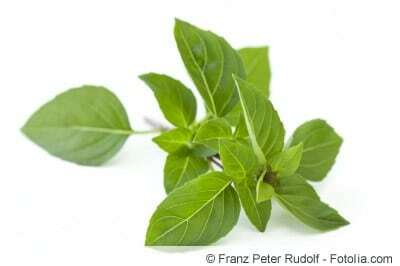
In contrast to the herb garden, indoor herbs do not get any rainwater, so they are completely dependent on additional watering processes. While most herbs don't need excessive watering, they don't do well with prolonged drought. If there are frequent trips and the casting units are not carried out regularly during this time then ideally herbs should be cultivated that require little water and prolonged drought can. Chemical fertilizers should be avoided completely, they distort the taste and are harmful to health. When it comes to fertilizing, many of the herb varieties are also relatively undemanding:
- Water regularly but sparingly
- Too much water and waterlogging causes herbs to rot quickly
- Drainage prevents overwatering
- Small shards of pottery, which are mixed under the potting soil, are ideal
- Apply fertilizer once or twice a year
- Compost fertilization or other organic fertilizers are ideal
- Fertilize in either spring and/or fall
harvest
Harvesting is possible all year round, but most herbs grow more slowly in winter, so harvesting should be more careful during this time. Fast-growing plants should be checked regularly and harvested more if they grow rampantly. The following procedure has proven itself during harvest:
- Either carefully pluck out the leaves of the herbs or cut them off with kitchen scissors
- Always take the leaves on the bottom first
- Do not pluck the basil leaves individually, but cut off the stalk
- Never cut off more than half to ensure continued growth
- Already weakening plants should be allowed to recover before the next harvest
Pests & Diseases
Unfortunately, even the herbs on the windowsill are not safe from diseases and pests, which are quite often attacked by small flies and lice. The causes often include excessive humidity in the kitchen, excessive watering units and rot spreading in the rootstock. For this reason, the herbal plants should only be watered when kept indoors and, if necessary, completely disposed of in the event of a heavy fly or lice infestation:
- Use watering units moderately, especially with Mediterranean herbs
- In case of lice infestation, shower herbs well and then let them dry
- Repeat the procedure several times in the case of stubborn infestation
- Put a soapy solution in a spray bottle instead of regular water
- Spray the entire plant, including the underside of the leaves
Conclusion
Herbs can also be easily planted in the home and harvested quickly and easily when needed. Herb plants thrive particularly well on a windowsill with sufficient incidence of light; sunny spots in the kitchen are ideal. Since the water and nutrient supply via rainwater and the soil is completely absent in indoor culture, these factors must be taken into account in the maintenance effort. As a rule, herbs are sold in quite small pots in specialist shops, in which case they should be transplanted into larger containers. In general, almost all known herbs can be planted on the windowsill at home, but the location requirements must be considered before buying. Regular watering and the use of organic fertilizers support a rich harvest and allow food and drinks to be prepared with fresh and tasty herbs all year round.
 garden editorial
garden editorial I write about everything that interests me in my garden.
Learn more about herb garden

Build your own herb bed: ideas for classic and modern beds
Herbs from the garden are a welcome and totally trendy thing. They are tasty and healthy as well. So it makes sense to build a herb bed. That can then also be designed in a modern way. There are ideas for this here.
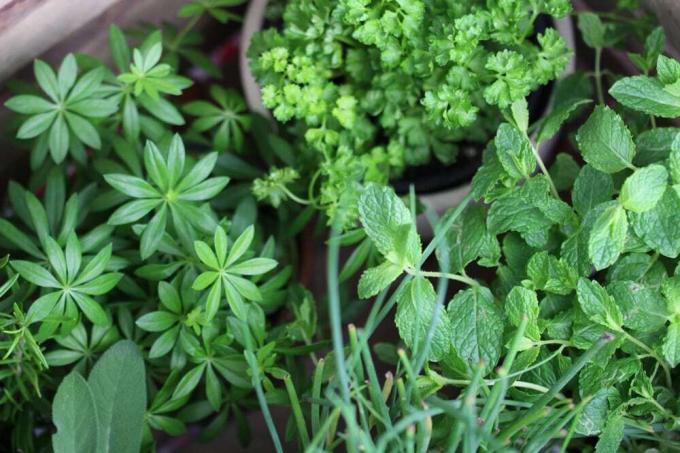
Mortar tub as a plant pot and herb bed
Mortar trays from the well-stocked hardware store are the ideal alternative for quickly and easily on the patio or balcony to conjure up a small herb bed or tomatoes, peppers but also flowering plants cultivate. The tubs are available in different sizes and shapes and thus fit into the smallest corner.

Perennial herbs in the herb garden - list of hardy varieties
Herbs are very popular among hobby gardeners, and rightly so! Because the plants are not only versatile, but also usually perennial and hardy! You can find out here which varieties you should definitely grow in your herb bed!

The best two herb snail building instructions
From the dry zone to the swamp area, the right climate zone for every herb. All of this in just three square meters. With a herb snail, you can create this small natural wonder, a so-called permaculture, in your own garden. There are multiple varieties and appearances and sizes, all of which follow basically the same building instructions.
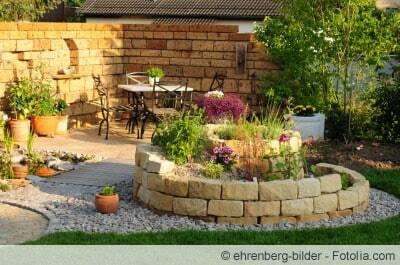
Creating a herb snail – instructions in 6 steps
With a herb snail, fresh kitchen herbs are always on the table, and they also have a high decorative value in the garden. The attractive herb bed in the form of a spiral grows upwards like a snail and therefore allows the planting of many different herbs with different demands on each Location.
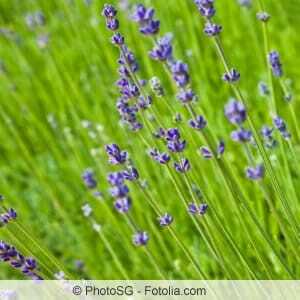
Lavender varieties - hardy species for the garden
Robust, strongly scented and used in the kitchen and as a remedy, everyone knows lavender. But be careful, because not all of the many varieties of lavender are suitable for cultivation in your garden bed at home. Because there are only a few varieties that are hardy and can survive a winter in the local latitudes outside.



